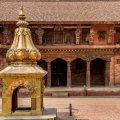Certainly the finest museum in the country, dedicated to the religious arts of Nepal, it's definitely worth a visit. Housed in the former palace of the Malla kings, built in 1734 in the heart of Durbar Square, the Keshav Narayan Chowk, the museum was inaugurated in 1997. It boasts a unique site, a haughty testimony to traditional Newar architecture. Although, like all the buildings, it was only slightly damaged by the 2015 earthquake, it has now been renovated. The café-restaurant has been renovated in the garden, offering an enchanting setting for a coffee break.
Visit. You'll need to take the time to explore the two floors and the first floor, and to read the many detailed explanations, both religious and historical. Alcoves and showcases highlight the exhibits (over 200 devotional objects, statues and sculptures). The whole is highly instructive, and the objects well displayed. Visitors learn how to recognize the gods: their positions, finery and clothing, and their attributes. The well-presented explanations help you find your way through the multitude of gods. The tour offers an interesting insight into Buddhism and Hinduism, a glimpse of the links between these two religions and, more generally, a different approach to Nepal's history. The exhibition also presents the different techniques used to create these remarkable pieces. The museum boasts an exceptional collection of bronze statues from the Malla period (XIIᵉ-XVIIIᵉ century). Highlights include the meditating Shakyamuni Buddha, Avalokiteshvara (Lokeshvara), bodhisattva of compassion, and the statue of Nataraja (dancing Shiva). Allow a good two hours to visit the whole complex. And you'll want to take a good look at Gallery H, where you'll discover that Durbar Square hasn't changed much in over a century. Very good souvenir, book and handicraft stores.
The garden and the royal bath. Among its many courtyards, the Tusha Hiti royal bath, dating back to the Malla period, is located within the old palace compound. Carved out of stone and accessible by stairs, this sunken pool features a cross- or lotus-shaped design, symbolizing spiritual purity. It is adorned with spouts carved with mythological creatures such as the makara. Once used for the ritual purification of the king, it is now a remarkable example of Newar architecture and hydraulic engineering.
Did you know? This review was written by our professional authors.
Book the Best Activities with Get Your Guide
Members' reviews on PATAN MUSEUM
The ratings and reviews below reflect the subjective opinions of members and not the opinion of The Little Witty.
Bien que les diverses expositions finement conçues soient merveilleuses, il n'y a rien de tel que de s'asseoir sur les coussins près des fenêtres supérieures et de regarder le paysage et les gens passer en contrebas.
(Il y a aussi un café haut de gamme à l'intérieur du musée, le jus de fruit était très bon)






J'ai visité la place Durbar de Patan samedi dernier et j'ai eu l'impression de pénétrer dans un musée vivant ! Chaque brique, chaque sculpture raconte une histoire. Le musée de Patan a été le point fort de ma visite. Il est magnifiquement conçu, paisible et riche d'art et d'histoire Newari. C'est un endroit où l'on ne se contente pas de voir la culture, mais où on la ressent.
Les boiseries complexes, les anciennes cours et l'énergie spirituelle en font un lieu à visiter absolument pour tous ceux qui aiment l'histoire, la photographie ou qui souhaitent simplement faire une pause dans le chaos moderne.
Je partage avec vous quelques clichés que j'ai pris - ils rendent à peine justice, mais j'espère qu'ils donneront envie à quelqu'un d'autre d'explorer ce joyau. Je recommande vivement d'y aller tôt le matin pour profiter de la lumière dorée et de l'absence de foule !